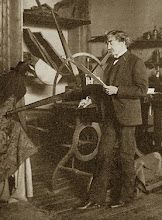
I took some advice from the Wet Canvas Forum to re-ground and re-bite the plate. Here is the 2nd proof of the re-bitten plate. For the most part I did not re-needle the original lines and concentrated on those areas that had not bitten at all the first time around. As I suppose was inevitable, the original lines and the newly bitten lines did not match exactly though I tried to stop out and time the biting so they would be as close as possible. The newly bitten lines ended up a bit darker so on the second proof I wiped those areas more to remove more ink. That worked pretty well as you may (or may not) agree, and if I spend more time I can probably get the match even closer. Comments would be very welcome.


+With+Press+cropped.jpg)



I would suggest you try to obfuscate your first etching instead of matching it. One of my favorite lines to repeat while I work on a plate is, "Every mark is a correction for the previous mark." Try adding darker values with your lines so that you hide your "foul" bite. I am partial to hatching and cross hatching when drawing my initial image. I like to do as much work as possible in the first bite. That first hard ground is always the easiest one to draw in.
ReplyDeleteHave you experimented with aqua-tint? I learned to do aquatint with a spray can instead of rosin. Makes for easier cleanup.
Here is an example of my line work.
http://www.flickr.com/photos/boundstaffpress/2324414525